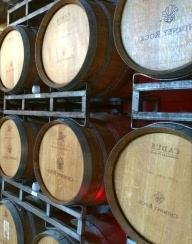How to detect multiple aromas?
The aroma of a young, unoaked wine is like a blended juice or herbal tea. This blend of aromas makes it almost impossible for those of us new to wine to single out distinct aromas.
However, if we are familiar with the individual fruit flavors in this blended juice or the ingredients in this herbal tea, identifying the aromas in the juice or tea might become a breeze.
A Kaleidoscope of Odors
Part of the difficulty in describing the aromas in wine stems from a lack of familiarity with the various aromas that can be described. “It’s just the aroma of grapes and alcohol,” one might think. Beyond these two basic aromas, one gradually discovers that wine is a diverse kaleidoscope of aromas.
With this in mind, it’s recommended to spend more time thinking about the aroma before sipping a glass of wine. Smelling is a unique pleasure of wine tasting and a way to open up your senses. To enrich your “odor memory bank,” consider smelling before eating. Slow down your pace and listen to and appreciate the people and things around you, transforming your experience into practical knowledge.
Where Does Smell Come From?
Before entering the “Kaleidoscope of Smell,” let’s first discuss where smells come from. The floral aroma of jasmine oolong tea comes from the addition of jasmine petals during the roasting process, giving the tea a subtle jasmine fragrance. So, does the blueberry aroma of wine come from the addition of blueberry extract during the brewing process?
Not necessarily. “Every knowledge has its own sequence, and every skill has its own specialization.” Tea, coffee, and wine—three intoxicating beverages—may have very different production processes, but surprisingly, they share a common denominator in their aroma.
Taking coffee as an example, the Specialty Coffee Association of America, an authority in the coffee industry, collaborated with the World Coffee Research Organization to officially update the Coffee Taster’s Flavor Wheel in 2016. They categorize coffee aromas into eight categories: floral, fruity, green/vegetable, spice, cocoa and nuts, roasted, acidic/fermented, and other.
Reading this, you might be wondering why we’re jumping to coffee aromas when we’re not discussing wine aromas. Since coffee is more popular than wine in Asia, starting with coffee aromas is a good starting point to make it easier for wine beginners to understand.
Three important tasting dimensions
The eight categories of coffee aroma are similar to the classification of wine aroma, but before we get into its main classification, let us first interpret the three important terms “taste”, “aroma”, and “flavor”. These three terms are similar at a distance, but different when viewed up close:
(1) Taste
When tasting food or drinks, the taste sensations in the mouth, especially on the tongue, are mainly sweet, salty, sour, bitter, and umami, which are somewhat different from the familiar “sour, sweet, bitter, and spicy”.
Spiciness is not a taste, but a touch. Spiciness is a pain caused by burning. Umami was defined as the fifth taste in a formal seminar in 1985. This is different from the commonly known “freshness”. “Umami” is also “flavor”. For example, in meat juice or fish sauce, two key substances can be found to achieve “umami”, namely glutamate (glutamine) and nucleotides.
(2) Aroma
The “smell” that is felt or smelled in the nose is also called “aroma”. Another word that can be translated as “aroma” is “Bouquet”. Both of them describe the smell that is smelled, but the standard of “aroma” varies depending on factors such as nationality, environment, and the specificity of the product. Therefore, “smell” is more appropriate than “aroma”.
However, in the smell of wine, the definitions of “aroma” and “Bouquet” are slightly different.
(3) Flavor
Combining taste and smell, the taste perceived in the mouth and nose is called “flavor”. The fusion of taste and smell is called “flavor”. Back to the topic, where does “smell” come from? Why are there many aromas other than grapes? Here we can discuss it from the “three stages”:
A. First stage of smell
Because the environment in which the grape variety grows and the grape variety itself have specific smells, for example: Cabernet Sauvignon has the smell of blackberries and blackcurrants. Pinot Noir has aromas of red cherries and cranberries. These pre-fermentation aromas are called “first-stage aromas.”
This stage is dominated by aromas of fruit, flowers, spices, plants, and soil. The first three are generally the easiest to describe and the most widely accepted. The second two also appear in wine, but they are less popular and are less commonly considered “aromas.”
When first tasting wine, if you can’t pinpoint a specific fruit or flower, you can start by describing the wine’s aroma in broad categories. As you sip more often, try to associate the aromas with the following specific categories. These are similar to, but not identical to, the aromas on the coffee flavor wheel.
Category 1: [Fruits]
- Red Fruits: Cranberries, red plums, pomegranates, cherries, strawberries, raspberries, etc.
- Black Fruits: Boysenberries, black currants, black cherries, blueberries, etc.
- Citrus: Lemon, lime, grapefruit, orange, marmalade, etc.
- Tropical Fruit: Pineapple, mango, guava, kiwi, lychee, etc.
- Tree Fruit: Quince, apple, pear, apricot, persimmon, etc.
- Dried Fruit: Raisins, dried figs, candied dates, etc.
Second Category: [Floral Fragrance]
Violet, rose, jasmine, lavender, iris, peony, elderflower, acacia, lilac, honeysuckle, hibiscus, etc.
Third Category: [Spices]
White pepper, red/black peppercorns, cinnamon, fennel, cloves, mint, thyme, etc.
Fourth Category: [Plants]
Tea, tomatoes, tomato leaves, bitter almonds, jalapenos, red/yellow/green bell peppers, grass, etc.
Category 5: [Soil]
Gasoline, volcanic rock, beetroot, potting soil, wet gravel, slate, etc.
B. Secondary Stage Aromas
These are aromas produced during the fermentation process, including those due to the action of yeast or other microorganisms. This is particularly true of sparkling wines produced through the “second fermentation in bottle” method, which can produce “yeasty” and “bready” notes. The following are the categories and subcategories of secondary stage aromas:
Category 6: [Microbial]
Cream, mushrooms, truffles, etc.
C. Third Stage Aromas
This stage refers to aromas developed during aging in oak barrels, cement barrels, or bottles. These aromas are called “bouquet” rather than “aroma.” The subcategories include:
Category 7: [Aging]
Oak barrel aging: Smoke, cigars, coconut, vanilla, etc.
General aging: Candied fruit, nuts, leather, cocoa, coffee, tobacco, etc.
Category 8: [Other]
The above are the aromas that a good bottle of wine can have. Of course, not every bottle of wine has these many aromas. These aromas depend on factors such as the grape variety used, the fermentation method, and whether the wine has been barrel-aged. Select the corresponding or associated aromas from these factors.


Leave a Reply